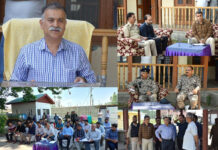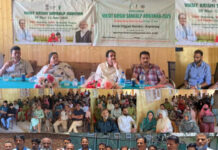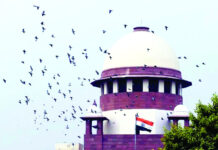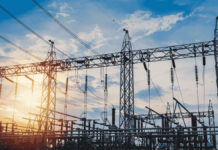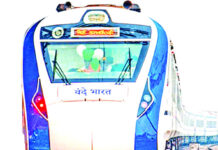Srinagar: Fast retreating of glaciers due to global warming and pollution has created glacial lakes in various mountain ranges of Jammu and Kashmir besides Ladakh making the Himalayan regions vulnerable to Glacial Lake Outburst Floods
GLOF can be disastrous for downstream populations due to sudden outburst of a glacial lake dammed by loose moraine material. The glacial lake outbursts can be catastrophic – destroying downstream infrastructure, resulting in fatalities and affecting livelihoods of mountain communities.
Scientific studies indicate that Kolahoi, the largest glacier of Kashmir valley’s Jhelum Basin, is retreating rapidly due to spurt rise in temperature triggered by global warming and extreme pollution.
Asthal village vulnerable to GLOF in case any of the two lakes L1 and L2 drain out rapidly.Photos courtesy: Dr Irfan Rashid
Thajiwas, Hoksar, Nehnar, Shishram, and glaciers around Harmukh are also retreating slowly.
Melting glaciers erode land and fill up the space creating glacial lakes.
Besides glacier recession, the prevailing warming scenario over the Himalaya makes communities and infrastructure more vulnerable to cryosphere-related hazards that were previously not experienced in the past.
“These include GLOF, rock-ice avalanches, glacier detachments, permafrost degradation-induced rock failures and debris flows. In the northwestern Himalayan regions of J&K and Ladakh, Leh and Kargil districts are more exposed to GLOF risk with 180 proglacial lakes most of which are expanding in area,” Dr Irfan Rashid, senior assistant professor of Department of Geo-informatics, University of Kashmir (KU) told Greater Kashmir.
On the basis of extensive scientific studies, Dr Rashid said in Kashmir valley, two proglacial lakes in the upstream of Vishaw in south Kashmir’s Kulgam district are susceptible to GLOFs that might affect Asthal village downstream.
He said Gya village located some 74 km from Leh experienced GLOFs moderate in August 2016 affecting built-up and agriculture downstream.
Another high-intensity GLOFs was experienced in Rumbak in Leh that destroyed three bridges and washed away several kilometers of roads in August 2021.
“While the number of proglacial lakes are high in Ladakh, downstream areas in Kashmir valley are more vulnerable owing to high population and greater area under infrastructure,” he said.
In the mountainous Kashmir Himalaya, below-normal snowfall during last winter’s accompanied by high winter temperatures and summer heat waves contributed significantly to high glacier melting.
Kolahoi Glacier has lost almost 23 percent of its area since 1962 and has fragmented into smaller parts.
While GLOFs may be triggered by a host of geomorphic and meteorological factors, there is a plethora of scientific literature suggesting that earthquakes exacerbate the cryosphere-related hazard cascade processes including glacial lake failures translating into GLOFs and rock-ice avalanches.
“This is especially important given the fact that there are around 5300 glacial lakes, thousands of ice-cliffs and permafrost on unstable steep slopes in the Indus Basin of which Jammu, Kashmir, and Ladakh regions are part of. Such cryosphere-related hazard cascades cannot be ruled out as these regions fall in highest earthquake risk zones (IV & V),” Dr Rashid said.
J&K falls under the high seismic Zones IV and V making it vulnerable to earthquakes. A powerful 7.6 magnitude earthquake rattled J&K on October 8, 2005, claiming 1350 lives and causing massive destruction to structures.
Drang Drung is the largest glacier in Zanskar and one of the fast-receding glaciers in Himalaya since the ice front is emptying into the Proglacial Lake. The lake started forming after 2008, currently spreading over 17 hectares and is projected to expand to 39 hectares.Photos courtesy: Dr Irfan Rashid
Noted earth scientist Prof Shakil Romshoo states that melting of glaciers in the last over six decades has resulted in the emergence of a number of dammed glacial lakes in the mountainous glaciated terrain.
“Several glacial lakes have developed in the last four decades in the Chenab, Zanskar and Leh regions and are growing in size,” he said.
Prof Romshoo recommends that it is important to continuously monitor these lakes by field and satellite-based studies and assess risk associated with the bursting of these dammed lakes so that the human habitations are warned well in time and the necessary mitigation measures initiated to minimise the damage in the eventuality of their outbursting.
He recommended that the hydropower and other river engineering structures downstream should be designed to withstand the disastrous surges of the water and debris associated with the bursting of the glacier lakes particularly in the Chenab valley where several hydropower projects are in operation.
“Since the development of the hydropower projects envisages huge financial investment, it is essential to consider the risks and hazards of all the potential glacier lake outbursts in the upstream of the projects. It is very important to assess the breaching risk of glacial lakes in the state and the likely damage it shall cause to the human habitations and Hydropower and other engineering river structures downstream so that the feasible mitigation measures for these hazards are taken urgently,” Prof Romshoo said.
On September 7, 2014, massive flow of water from higher reaches following heavy rainfall led to overflowing in Jhelum, Chenab, and Tawi basins causing devastating floods in J&K.
In January 2015, an artificial lake was created due to landslides in the Phutkal area of Zanskar in Kargil. Experts had warned that delay in addressing the issue could cause “catastrophic flash floods” in downstream areas of Zanskar Valley.
Two months later, a high-level team from the National Disaster Management Authority created a channel to drain the accumulated water, but to no avail.
On May 7, 2015, the artificial lake burst triggering flash floods washing away several bridges and caused extensive damage to houses.
Three million Indians live in areas where a GLOF could happen at any time, the first global assessment of such areas has found globally, 90 million people across 30 countries live in 1089 basins containing glacial lakes.
Of these, 15 million (16.6 percent) live within 50 km of a glacial lake, said the new study published in Nature Communications on February 7, 2023.
It states that the majority of the globally exposed population amounting to 9.3 million (62 percent) are located in the region of High Mountain Asia (HMA).
India, Pakistan, Peru and China accounted for more than 50 percent of the globally exposed population to GLOFs.
According to Centre for Science and Environment and Down to Earth’s State of India’s Environment 2022, here has been a 40 percent increase in water spread area in India, China and Nepal, posing a huge threat to seven Indian states and Union Territories including Jammu and Kashmir, Ladakh, Himachal Pradesh, Sikkim, Assam and Arunachal Pradesh.
In Kedarnath area in Uttarakhand, an estimated 5700 people, mostly pilgrims, died on June 16, 2013, due to heavy rains, cloudburst, and outburst from Chorabari Lake.
On February 7, 2021, a part of the Nanda Devi Glacier broke off at Joshimath in Uttarakhand’s Chamoli district, killing at least seven people and leaving around 150 missing and feared dead.
The flash flood breached two hydropower projects near the Naina Devi National Park, about 300 km north of Dehradun.
The J&K Government has devised an action plan on climate change recommending a slew of measures with institutional structure to address both adaptation and mitigation concerns with an objective of increasing resilience and climate proofing of the sectors keeping in mind conditions of the local vulnerabilities.


